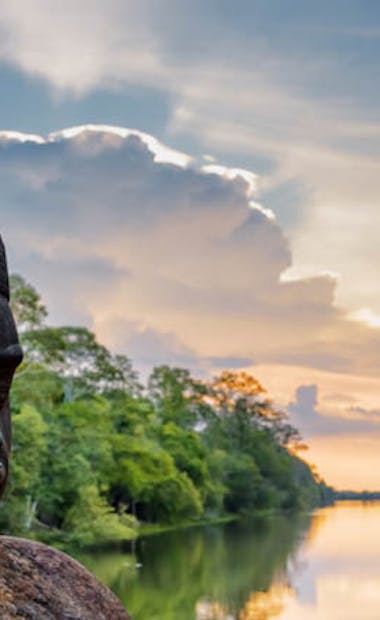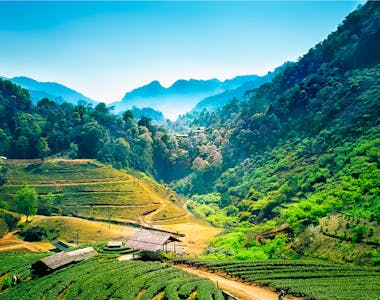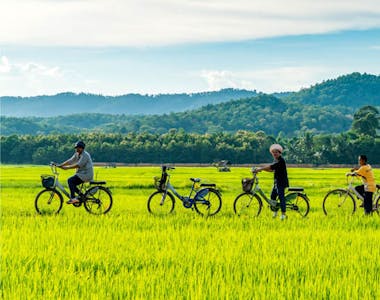
South East Asia Tours
South East Asia tours including trekking, sailing, cycling and more!
Popular tours
- Save31%
 View Tour
View TourBali Experience - 10 Days
- Canggu to Gili Islands
- Age group: 18 - 39
- Max group size: 20
Was:£595From£412 - Save35%
 View Tour
View TourIndonesia: Hammocks & Hikes - 14 Days
- Jakarta to Kuta
- Age group: 18 - 39
- Max group size: 18
Was:£1,299From£840 - Save33%
 View Tour
View TourClassic Bali - 8 Days
- Sanur Beach to Candidasa
- Age group: 12 - 100
- Max group size: 16
Was:£619From£413 - Save32%
 View Tour
View Tour31-Day Southeast Asia Adventure: Thailand, Laos, Vietnam, and Cambodia
- Bangkok to Siem Reap
- Age group: 18 - 45
- Max group size: 25
Was:£2,428From£1,657 - Save32%
 View Tour
View Tour20-Day Vietnam to Cambodia: Hanoi, Ha Long Bay, Hoi An, Ho Chi Minh City, and Angkor Wat
- Hanoi to Siem Reap
- Age group: 18 - 45
- Max group size: 23
Was:£1,459From£996 - Save31%
 View Tour
View TourThailand & Laos Adventure - 13 Days
- Bangkok to Vientiane
- Age group: 15 - 99
- Max group size: 16
Was:£1,580From£1,095
South East Asia Tours
Welcome to the enchanting realm of South East Asia, a captivating tapestry of diverse cultures, breath-taking landscapes, and ancient wonders. Embark on a transformative journey as you explore this vibrant region, where every step reveals an intoxicating blend of tradition and modernity. Our South East Asia tours promise to unveil the hidden gems and iconic landmarks that make this part of the world a true traveller's paradise.
Immerse yourself in the bustling streets of Bangkok, the vibrant capital of Thailand, where ancient temples coexist with towering skyscrapers. Indulge in the tantalizing flavours of street food, embark on a tuk-tuk adventure, or explore the serene canals of the city's floating markets. Thailand's pristine beaches and lush tropical islands, such as Phuket and Koh Samui, offer idyllic retreats for sun-seekers and water sports enthusiasts.
Journey to the heart of Cambodia and discover the awe-inspiring temples of Angkor Wat, a UNESCO World Heritage site. Be mesmerized by the intricate carvings and architectural wonders that showcase the grandeur of the Khmer Empire. Explore the charming capital city of Phnom Penh, where French colonial architecture stands alongside bustling markets and vibrant street life.
In Vietnam, lose yourself in the enchanting alleys of Hanoi's Old Quarter, where the past blends seamlessly with the present. Cruise through the mystical waters of Ha Long Bay, with its limestone karsts rising from emerald waters, creating a breath-taking panorama. Explore the vibrant markets of Hoi An, where traditional crafts and delicious cuisine await.
Experience the spiritual serenity of Laos as you navigate the tranquil waters of the Mekong River. Discover the ancient city of Luang Prabang, a UNESCO World Heritage site, where saffron-robed monks stroll through streets lined with ornate temples. Immerse yourself in the local culture as you witness the alms-giving ceremony at sunrise or explore the picturesque Kuang Si Waterfalls.
Indonesia, with its stunning archipelago, promises an abundance of natural beauty. Marvel at the iconic Borobudur Temple in Yogyakarta, witness the traditional dance performances of Bali, and lose yourself in the cultural melting pot of Jakarta, the vibrant capital. Bali's pristine beaches, lush rice terraces, and vibrant arts scene make it a destination of unparalleled charm.
Discover Malaysia's dynamic blend of cultures in Kuala Lumpur, where the Petronas Twin Towers dominate the skyline. Explore the UNESCO-listed George Town in Penang, known for its rich history and mouth-watering street food. Venture into the lush rainforests of Borneo to encounter exotic wildlife, including orangutans and proboscis monkeys.
These are just glimpses of the myriad of experiences awaiting you in South East Asia. From the tranquil beauty of Myanmar's temples to the vibrant energy of Singapore's cityscape, this region offers something for every traveller. Whether you seek cultural immersion, thrilling adventures, or tranquil escapes, South East Asia will capture your heart and leave you with memories to last a lifetime.
Join us on our South East Asia holidays and let us guide you through this captivating tapestry of colours, flavours, and traditions. Unlock the secrets of this remarkable region as you embark on an unforgettable journey that will ignite your senses and broaden your horizons. South East Asia awaits, ready to unveil its wonders and create memories that will stay with you forever.
When is the best time to visit South East Asia?
The best time to visit South East Asia depends on the specific countries you plan to visit, as the region experiences varying climates throughout the year. Generally, the dry season is the most popular time to visit, offering pleasant weather and optimal conditions for outdoor activities. Here's a breakdown of the seasons in different countries:Thailand: November to February is the cool and dry season, making it an ideal time to explore Bangkok, Chiang Mai, and the islands.
Cambodia: November to March is considered the best time to visit, with cooler temperatures and less rainfall. The peak season is December and January.
Vietnam: The best time to visit is during the dry season from November to April, although the weather can vary from north to south.
Laos: The dry season from November to April is the most popular time to visit, as the weather is pleasant for outdoor activities and exploring Luang Prabang.
Indonesia: May to September is the dry season, offering the best weather for exploring Bali, Java, and other islands. However, some areas like Ubud can be crowded during this time.
Malaysia: The west coast experiences its dry season from November to March, while the east coast has its dry season from April to October. Kuala Lumpur is generally pleasant year-round.
It's essential to research the specific country or countries you plan to visit in South East Asia to determine the best time based on weather patterns and local events. Keep in mind that popular tourist destinations can be crowded during peak seasons, so consider your preferences and travel priorities when planning your trip.
Will I need a visa to travel to South East Asia?
The visa requirements for South East Asia vary depending on the country you plan to visit and your nationality. Here's a general overview:
Thailand: Many nationalities can enter Thailand for tourism purposes without a visa and receive a visa exemption stamp upon arrival, usually valid for 30 days. However, if you plan to stay longer or have a different purpose of visit, you may need to apply for a tourist visa in advance.
Cambodia: Most nationalities can obtain a tourist visa on arrival at the airports and land borders, valid for 30 days. Alternatively, you can apply for an e-visa or obtain a visa from a Cambodian embassy or consulate before traveling.
Vietnam: Most visitors to Vietnam need a visa in advance. You can apply for an e-visa or obtain a visa on arrival with pre-arranged approval. Some nationalities are exempt from a visa for a specified period, typically 14-30 days.
Laos: Many nationalities can obtain a visa on arrival at the international airports and land borders, valid for 30 days. Alternatively, you can apply for a visa in advance at a Lao embassy or consulate.
Indonesia: Visitors from many countries can enter Indonesia without a visa for a certain period, typically 30 days, for tourism purposes. This visa exemption can usually be extended once for an additional 30 days if needed.
Malaysia: Visa requirements vary depending on your nationality. Many countries have visa-free entry for a specified period, typically 30-90 days, while others require a visa obtained in advance or on arrival.
It's important to check the visa requirements well in advance of your trip and ensure that your passport is valid for at least six months beyond your planned departure date. Consult the official websites of the embassies or consulates of the countries you plan to visit or seek advice from a reliable visa service to obtain the most up-to-date and accurate information based on your specific circumstances.
What are the must see destinations in South East Asia?
South East Asia is a diverse and captivating region, offering a wealth of must-see destinations. Here are some top picks:
Bangkok, Thailand: Immerse yourself in the vibrant capital city of Thailand, known for its bustling markets, ornate temples, and mouth-watering street food.
Angkor Wat, Cambodia: Explore the magnificent Angkor Wat temple complex in Siem Reap, a UNESCO World Heritage site and one of the most important archaeological sites in Southeast Asia.
Halong Bay, Vietnam: Cruise through the breath-taking limestone karsts and emerald waters of Halong Bay, a UNESCO World Heritage site, and experience the unique beauty of this natural wonder.
Luang Prabang, Laos: Discover the serene charm of Luang Prabang, a UNESCO World Heritage city famous for its well-preserved temples, traditional architecture, and tranquil atmosphere.
Bali, Indonesia: Relax on the stunning beaches of Bali, soak up the island's rich culture, visit ancient temples, indulge in spa treatments, and enjoy the vibrant nightlife.
Kuala Lumpur, Malaysia: Experience the modern and cosmopolitan city of Kuala Lumpur, home to iconic landmarks such as the Petronas Twin Towers, vibrant markets, and a diverse culinary scene.
Bagan, Myanmar (Burma): Marvel at the thousands of ancient temples and pagodas scattered across the vast plains of Bagan, creating a surreal and mesmerizing landscape.
Singapore: Discover the blend of cultures, stunning architecture, and culinary delights in the modern city-state of Singapore, home to attractions like Gardens by the Bay and Sentosa Island.
Hoi An, Vietnam: Wander through the charming streets of Hoi An, known for its beautifully preserved ancient town, colourful lanterns, and delicious local cuisine.
Phuket, Thailand: Relax on the pristine beaches of Phuket, enjoy water sports, explore nearby islands, and experience the vibrant nightlife.
These are just a few highlights, and there are many more incredible destinations to explore in South East Asia. Each country has its unique attractions, cultural experiences, and natural wonders that make the region a treasure trove for travellers.
What are the local currencies in South East Asia, and can I use credit cards?
South East Asia comprises several countries, each with its own currency. Here are the local currencies for some popular destinations in the region:
- Thailand: Thai Baht (THB)
- Cambodia: Cambodian Riel (KHR), although the US Dollar (USD) is widely accepted.
- Vietnam: Vietnamese Dong (VND)
- Laos: Lao Kip (LAK)
- Indonesia: Indonesian Rupiah (IDR)
- Malaysia: Malaysian Ringgit (MYR)
- Singapore: Singapore Dollar (SGD)
In major cities and tourist areas, credit cards are widely accepted at hotels, restaurants, and larger establishments. Visa and Mastercard are the most commonly accepted cards, followed by American Express and Discover, which may have more limited acceptance. However, it's important to carry cash, especially when visiting rural areas, local markets, or smaller establishments where credit card facilities may not be available.
Before your trip, inform your bank or credit card provider about your travel plans to avoid any issues with card usage abroad. Additionally, be aware of potential fees for foreign transactions or currency conversions and consider carrying a mix of cash and cards for convenience and flexibility.
Is South East Asia a good family holiday destination?
Absolutely! South East Asia is a fantastic family holiday destination with a wide range of activities and attractions that cater to all ages. Here's why South East Asia is popular among families:
Family-friendly accommodations: The region offers a variety of family-friendly accommodations, including resorts with kid's clubs, pool facilities, and spacious rooms or villas suitable for families.
Beautiful beaches: South East Asia is renowned for its stunning beaches, where families can relax, swim, and engage in water sports together. Destinations like Phuket in Thailand, Bali in Indonesia, and Langkawi in Malaysia are particularly popular.
Cultural experiences: South East Asia is rich in cultural heritage, providing opportunities for families to explore ancient temples, traditional markets, and vibrant festivals. Learning about local customs and traditions can be both educational and exciting for children.
Wildlife and nature: The region is home to diverse ecosystems and abundant wildlife. Families can visit national parks, go on wildlife safaris, or enjoy outdoor activities like jungle trekking and river cruises, allowing kids to connect with nature.
Adventure activities: South East Asia offers various adventure activities suitable for families, such as zip-lining, snorkeling, kayaking, and cycling. These experiences create lasting memories and foster a spirit of adventure among family members.
Affordable options: The region provides a range of budget-friendly options for accommodation, dining, and transportation, making it an affordable choice for family holidays.
Warm hospitality: South East Asians are known for their warm hospitality and love for children. Families will find locals welcoming and accommodating, creating a friendly and safe environment for their vacation.
However, it's important to plan your trip and choose activities that suit your family's preferences and age range. Keep in mind factors such as weather, safety precautions, and health considerations. With proper planning and research, South East Asia can offer an unforgettable and enjoyable experience for the whole family.
Is South East Asia a good destination for solo travellers?
Yes, South East Asia is a fantastic destination for solo travellers. Here are a few reasons why:
Backpacking culture: South East Asia has long been a popular destination for backpackers and solo travellers. It offers a well-established backpacking infrastructure, including budget accommodations, affordable transportation options, and a network of fellow travellers. This makes it easy to connect with like-minded individuals and form friendships along the way.
Safety: South East Asia, in general, is considered a safe region for solo travellers. Of course, it's important to take standard precautions as you would in any destination, such as staying aware of your surroundings and avoiding risky situations. Exercise caution with your belongings, use reliable transportation, and choose reputable accommodations.
Welcoming locals: The people of South East Asia are known for their warm hospitality and friendliness towards travellers. Solo travellers often find it easy to strike up conversations and make connections with locals, who are often more than happy to share their culture and provide tips for exploring their country.
Variety of experiences: South East Asia offers a diverse range of experiences for solo travellers. From exploring ancient temples and vibrant markets to enjoying pristine beaches and thrilling adventure activities, there's something for everyone. You can immerse yourself in the local culture, try delicious street food, participate in yoga retreats, or even volunteer with community projects.
Solo traveller-friendly destinations: Several destinations within South East Asia are particularly popular among solo travellers. Places like Bali in Indonesia, Chiang Mai in Thailand, Hanoi in Vietnam, and Siem Reap in Cambodia have well-established solo traveller scenes, with numerous hostels, guesthouses, and social activities that make it easy to meet other travellers.
Affordability: South East Asia is known for its affordability, making it attractive to solo travellers on a budget. Accommodations, meals, transportation, and activities are often much more affordable compared to other regions, allowing solo travellers to stretch their budget and enjoy an extended trip.
Whether you're seeking adventure, cultural immersion, or personal growth, South East Asia offers a welcoming and exciting environment for solo travellers. Embrace the freedom, make new connections, and create unforgettable memories in this vibrant and diverse part of the world.
Is South East Asia a safe destination?
South East Asia, in general, is considered a safe destination for travellers. However, it's important to exercise caution and take standard safety precautions as you would in any foreign country. Here are some points to consider:Personal safety: South East Asia is relatively safe, with low levels of violent crime. However, it's always advisable to stay aware of your surroundings, especially in crowded areas and tourist hotspots. Take precautions against pickpocketing and keep your belongings secure.
Health and hygiene: While South East Asia offers incredible experiences, it's essential to pay attention to your health and take necessary precautions. Stay hydrated, use sunscreen, and be cautious about street food and water quality. Consult with a healthcare professional before your trip to ensure you are up to date with necessary vaccinations and to receive any specific travel advice.
Transportation safety: When using transportation in South East Asia, choose reputable and licensed services. Be cautious when riding motorcycles or renting scooters, as road conditions and traffic can be challenging in some areas. Follow local traffic rules and wear appropriate safety gear.
Scams and touts: Like many tourist destinations, South East Asia may have instances of scams or touts targeting unsuspecting travellers. Be cautious of overly friendly strangers offering unsolicited help or deals that seem too good to be true. Research common scams beforehand to familiarize yourself with them and stay vigilant.
Natural hazards: South East Asia is prone to natural hazards such as typhoons, monsoons, and earthquakes. Stay informed about weather conditions and follow any advisories or warnings issued by local authorities. If you plan to engage in outdoor activities or adventure sports, choose reputable operators and follow safety guidelines.
It's always recommended to check the travel advisories provided by your government or relevant authorities before planning your trip. These advisories offer up-to-date information on safety, security, and health concerns specific to South East Asian countries.
By being prepared, staying informed, and exercising common sense, you can have a safe and enjoyable experience while exploring the wonders of South East Asia.
Will I require any vaccinations to travel to South East Asia?
Yes, it is advisable to check with your healthcare provider or a travel medicine specialist regarding the specific vaccinations recommended for your trip to South East Asia. The recommended vaccinations may vary depending on factors such as your destination, the duration of your stay, the activities you plan to engage in, and your individual health status. Here are some commonly recommended vaccinations for South East Asia:
Routine vaccinations: Ensure that you are up to date on routine vaccinations such as measles-mumps-rubella (MMR), diphtheria-tetanus-pertussis (DTaP), varicella (chickenpox), polio, and influenza.
Hepatitis A: This vaccination is recommended for all travellers to South East Asia, as the risk of exposure to contaminated food and water is relatively high.
Typhoid fever: Typhoid vaccination is recommended, particularly if you will be staying in rural areas or eating street food where sanitation and food hygiene may be a concern.
Hepatitis B: Hepatitis B vaccination is recommended for travellers who may come in contact with blood or body fluids, such as through medical procedures, tattooing, or unprotected sexual activity.
Japanese encephalitis: If you plan to spend an extended period in rural farming areas or during the peak transmission season, particularly in countries like Cambodia, Laos, or rural areas of Thailand, Vietnam, or Myanmar, vaccination against Japanese encephalitis may be recommended.
Rabies: If you anticipate close contact with animals or engaging in activities that increase the risk of animal bites, such as caving or outdoor activities, consider discussing the need for a rabies vaccination with your healthcare provider.
Remember that this is a general guideline, and the specific vaccinations you need may vary based on your individual circumstances. It is recommended to consult with a healthcare professional or travel medicine specialist well in advance of your trip to discuss your itinerary, medical history, and receive personalized advice regarding vaccinations and other travel health considerations.
How does the rooming work on tours?
Small group tours in South East Asia typically involve a set itinerary where you travel with a group of fellow travellers and a tour leader/guide. Accommodation arrangements vary depending on the specific tour you choose. Here are some common aspects of rooming arrangements on small group tours:
Shared Rooms: In order to promote camaraderie and facilitate interaction among group members, most tours arrange shared accommodation. This means you will be paired with another member of the same gender from the group to share a room. Roommates may sometimes change periodically throughout the tour.
Single Supplement: If you prefer to have your own room and privacy, you may have the option to pay a single supplement fee. This additional fee allows you to have your own room for the duration of the tour. However, please note that single supplements can vary in cost and availability.
Roommate Matching: Tour operators usually offer roommate matching services, where they try to pair you with a suitable roommate based on your preferences, such as age range. This can help ensure compatibility and a more enjoyable experience for all participants.
Rooming Preferences: When booking your small group tour, it's important to communicate your rooming preferences to the tour operator. If you have specific requirements or preferences, such as sharing with a friend or a specific roommate request, it's advisable to inform the tour operator during the booking process.
It's important to carefully read the tour details and inclusions provided by the tour operator to understand their specific rooming policies. If having your own room is a priority, make sure to inquire about the availability of single supplements and any associated costs before booking your tour.
Keep in mind that while sharing a room with a fellow traveller can be a great way to meet new people and build connections, having your own room provides more privacy and flexibility. Consider your preferences and the dynamics of the tour when deciding whether to opt for a shared room or pay for a single supplement.
Remember to communicate your needs and preferences clearly with the tour operator during the booking process to ensure a comfortable and enjoyable accommodation experience on your small group tour in South East Asia.
What is the food like in South East Asia?
The food in South East Asia is incredibly diverse, vibrant, and renowned for its flavours and aromas. Each country in the region has its own culinary traditions and specialties, offering a wide range of delicious dishes. Here are some highlights of the South East Asian cuisine:
Thai Cuisine: Thai food is known for its balance of sweet, sour, salty, and spicy flavours. Popular dishes include Pad Thai (stir-fried noodles), Tom Yum (spicy and sour soup), Green Curry, Massaman Curry, and Mango Sticky Rice.
Vietnamese Cuisine: Vietnamese cuisine is fresh, light, and full of herbs and vegetables. Pho (noodle soup), Banh Mi (baguette sandwiches), and Fresh Spring Rolls are some of the iconic dishes. Vietnamese cuisine also incorporates French influences, adding a unique touch to its culinary offerings.
Indonesian Cuisine: Indonesian food varies across the archipelago but is often characterized by rich spices and flavours. Nasi Goreng (fried rice), Satay (grilled skewered meat), and Gado-Gado (vegetable salad with peanut sauce) are popular Indonesian dishes.
Malaysian Cuisine: Malaysian cuisine is a fusion of Malay, Chinese, Indian, and indigenous influences. Nasi Lemak (coconut rice dish), Laksa (spicy noodle soup), Roti Canai (flaky flatbread), and Satay are some of the must-try dishes.
Singaporean Cuisine: Singaporean food reflects its multicultural society, blending Chinese, Malay, Indian, and Peranakan flavours. Hainanese Chicken Rice, Chili Crab, Laksa, and Roti Prata are some of the iconic dishes that showcase the diverse culinary heritage of Singapore.
Filipino Cuisine: Filipino cuisine combines indigenous, Spanish, Chinese, and American influences. Adobo (marinated meat), Sinigang (sour soup), Lechon (roast pig), and Halo-Halo (mixed dessert) are popular dishes in the Philippines.
Apart from these highlights, South East Asia offers a plethora of street food stalls, night markets, and local eateries where you can explore a variety of flavours and regional specialties. From spicy curries to refreshing tropical fruits, there is something to satisfy every palate. Don't miss the opportunity to indulge in local street food, sample traditional delicacies, and immerse yourself in the culinary culture of South East Asia.
Can I drink the tap water in South East Asia?
In general, it is not recommended to drink tap water in most parts of South East Asia. While the water quality varies across countries and regions, the tap water may not be safe for consumption due to the presence of bacteria, parasites, or other contaminants that can cause waterborne illnesses.
To ensure your health and safety, it is advisable to drink bottled water or use water that has been properly treated and filtered. You can easily find bottled water in convenience stores, supermarkets, and hotels throughout the region. It is important to check that the seal on the bottle is intact before purchasing.
Additionally, when brushing your teeth or rinsing your mouth, it is recommended to use bottled or filtered water. Avoid swallowing water while showering or swimming in freshwater bodies such as rivers or lakes, as they may contain harmful bacteria or parasites.
It's worth noting that some hotels and accommodations in South East Asia provide filtered or treated water for guests. Inquire with your accommodation about the availability of safe drinking water.
By taking these precautions, you can minimize the risk of waterborne illnesses and enjoy a healthy and enjoyable trip to South East Asia.
Are there any cultural norms in South East Asia I should follow?
Yes, South East Asia has diverse cultural norms and practices that visitors should be aware of and respect. Here are some general cultural norms to keep in mind when traveling in South East Asia:Dress Appropriately: Many countries in South East Asia have conservative cultural norms, so it's important to dress modestly, especially when visiting religious sites or local communities. Avoid wearing revealing clothing or shorts, and opt for clothes that cover your shoulders and knees.
Remove Shoes: It is customary to remove your shoes before entering homes, temples, and certain establishments in South East Asia. Pay attention to signage or follow the lead of the locals.
Respect for Elders and Authority: South East Asian cultures often place great importance on respecting elders and those in positions of authority. Show deference and avoid confrontational or disrespectful behaviour.
Greetings: Greet people with respect and courtesy. In many South East Asian countries, a slight bow, a nod, or placing your hands together in a prayer-like gesture (known as a wai in Thailand or sampeah in Cambodia) is a common greeting.
Etiquette in Religious Sites: When visiting temples or religious sites, observe and follow any rules or customs in place. Dress appropriately, speak softly, and avoid any disrespectful behaviour.
Food Etiquette: South East Asian countries have their own dining customs. In general, it is polite to wait for the host or elder to start eating before you begin. If dining with your hands, use your right hand, as the left hand is considered unclean in many cultures.
Personal Space and Touching: Respect personal space and avoid touching people, especially of the opposite sex, unless you have established a friendly rapport.
Bargaining: Bargaining is a common practice in markets and street stalls in South East Asia. However, do so with respect and in good humour. Remember that haggling too aggressively can be seen as disrespectful.
Local Customs and Traditions: Familiarize yourself with local customs and traditions specific to the country you are visiting. For example, in Thailand, it is important to show respect for the monarchy, while in Indonesia, it is customary to use your right hand for eating and handing objects.
By being mindful of these cultural norms and showing respect for local customs, you can have a more enriching and positive experience in South East Asia while fostering cultural understanding and appreciation.
What should I pack for a trip to South East Asia?
When packing for a trip to South East Asia, it's essential to consider the region's climate, culture, and activities. Here are some items you should include in your packing list:
Lightweight Clothing: Pack breathable and lightweight clothing suitable for the hot and humid climate of South East Asia. Choose loose-fitting garments made from natural fabrics like cotton or linen to help you stay cool and comfortable.
Sun Protection: Don't forget to pack sunscreen with a high SPF, sunglasses, and a wide-brimmed hat to protect yourself from the strong tropical sun.
Insect Repellent: South East Asia is known for its mosquito population, so pack a good quality insect repellent to protect yourself from mosquito bites. Consider products with DEET or other effective ingredients.
Comfortable Shoes: Bring comfortable walking shoes or sandals suitable for exploring cities, temples, and natural attractions. Also, consider water shoes if you plan to engage in water activities or visit beaches.
Travel Adapter: South East Asia typically uses a variety of plug types, so it's advisable to bring a universal travel adapter to ensure you can charge your electronic devices.
Medications: If you take any prescription medications, ensure you have an ample supply for the duration of your trip. Additionally, consider packing a basic first aid kit, including over-the-counter medications for common ailments like headaches, stomach issues, and allergies.
Lightweight Rain Gear: South East Asia can experience sudden showers, especially during the rainy season. Pack a lightweight rain jacket or travel umbrella to stay dry.
Travel Documents: Bring essential travel documents such as your passport, visa (if required), travel insurance, and copies of important documents (e.g., passport, itinerary). It's also helpful to have a small travel wallet or organizer to keep these documents secure and easily accessible.
Electronics: Don't forget to bring your camera or smartphone to capture memorable moments. Consider packing a power bank or portable charger for your electronics, as power outlets may not always be readily available.
Daypack or Backpack: A small daypack or backpack is useful for carrying essentials during day trips, hikes, or exploring the cities. It's also handy for storing items like water bottles, snacks, and souvenirs.
Remember to pack light and leave some space in your luggage for any souvenirs or items you might acquire during your trip. It's also a good idea to check the specific weather conditions and cultural requirements of the countries you plan to visit in South East Asia to tailor your packing list accordingly.


Book With Confidence
Monthly Payments
Spread the costs with no interest or additional fees
Best Price Guarantee
We won't be beaten on price. If you find this adventure at a lower price please get in touch!
Reserve now & pay later
Reserve your adventure today and pay later, free of charge
ATOL protected
Book with confidence
Hold your space today, for free
or book your trip with a deposit and then pay the rest in instalments.
Reserve your flights with us
Add flights to your booking and we'll take care of the rest. You'll get 24/7 support from our team & ATOL protection.
Speak to our experts
Call or email our expert team to find out more and help with ideas and planning.









